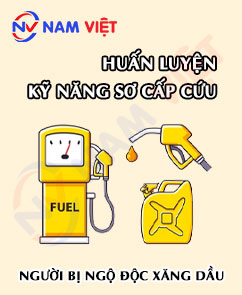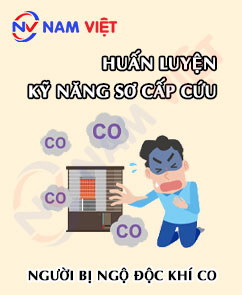First aid training for individuals poisoned by petroleum products
500,000 ₫
Note: The above price is calculated per person. Prices may vary depending on the number of participants in the course and market fluctuations. For more accurate pricing, please refer to the price list or contact our consulting staff directly.
Table of Contents
Toggle1. Identifying a Person with Gasoline Poisoning
a. Cases of gasoline poisoning
Gasoline poisoning is a dangerous condition that requires immediate intervention. Here are some common cases of gasoline poisoning:
- Skin contact: The victim may be poisoned through skin contact, especially if the skin is soaked in gasoline for a long time or if there is an open wound.
- Inhalation of gasoline fumes: The victim may inhale gasoline fumes in an environment with high concentrations or during explosions and fires.
- Ingestion: The victim may swallow gasoline accidentally or intentionally.

b. Signs indicating someone is at risk of gasoline poisoning
There are several signs indicating that a person may be at risk of gasoline poisoning. Key signs include:
- Fatigue and weakness: The victim may become tired, weak, and lose strength.
- Difficulty breathing: Gasoline poisoning can cause breathing difficulty, rapid breathing, or labored breathing.
- Nausea and vomiting: The victim may feel nauseous and vomit frequently.
- Headache and dizziness: Headache and dizziness are other common signs of gasoline poisoning.
- Changes in mood: The victim may become agitated, paranoid, or psychologically unstable.
- Skin and eye irritation: Gasoline poisoning can cause skin irritation, swelling, redness, itching, or watery eyes.
- Respiratory symptoms: The victim may experience coughing, hoarseness, or difficulty breathing.
- Digestive symptoms: Digestive symptoms may include abdominal pain, diarrhea, or constipation.

c. Assessing the condition of a victim of gasoline poisoning
The condition of a gasoline poisoning victim can vary depending on the level and duration of exposure. Common conditions include:
- Respiratory issues: Gasoline poisoning can cause respiratory failure, difficulty breathing, rapid breathing, or respiratory arrest.
- Cardiovascular issues: Gasoline can affect the heart, causing irregular heart rate, tachycardia, bradycardia, or low blood pressure.
- Nervous system issues: Gasoline poisoning can cause dizziness, lightheadedness, seizures, psychosis, paranoia, or loss of consciousness.
- Digestive issues: The victim may experience nausea, vomiting, abdominal pain, diarrhea, or constipation.
- Skin and eye issues: Gasoline can irritate the skin, causing burns, redness, itching, or tearing.
- Central nervous system issues: Severe gasoline poisoning can affect the central nervous system, causing seizures, loss of balance, reduced motor control, and brain damage.

d. Golden time for gasoline poisoning cases
The golden time is a critical and decisive period for gasoline poisoning cases. Prompt and effective intervention can save the victim’s life and minimize serious complications. The golden time for gasoline poisoning includes:
- Call emergency services immediately: As soon as you recognize gasoline poisoning, call emergency services for professional medical assistance.
- Move the victim away from danger: If the victim is in a gasoline-contaminated area, safely move them away from the source of danger. Ensure safety for both you and the victim during the process.
- Provide basic first aid: While moving the victim or waiting for rescue, provide basic first aid such as performing CPR if necessary and you are trained.
- Do not give the victim water: If the victim is unconscious or not fully alert, do not give water or take other actions without medical guidance.
Note that the golden time may vary depending on the victim’s condition and symptom progression. The most important action is to contact emergency services immediately and follow their instructions.

2. Overview of first aid training for gasoline poisoning
a. What is a first aid training course?
A first aid training course is a program designed to help learners master basic and advanced first aid skills. The program includes lessons and practical exercises on handling emergencies such as cardiac arrest, respiratory failure, poisoning, injuries, and other urgent situations.
The purpose of the first aid training course is to equip learners with the skills needed to respond to emergencies, minimize harm to themselves and others, and increase survival chances while ensuring timely transfer to medical facilities.
REGISTER FOR BASIC FIRST AID TRAINING
b. Training duration
Initial first aid training:
- For employees: 4 hours.
- For first aid and emergency responders: 16 hours (2 days).
Periodic first aid training:
- For employees: 2 hours.
- For first aid and emergency responders: 8 hours (1 day).
c. Course content
- Basic principles of first aid and on-site emergency care
- Wound bandaging (principles, tools, techniques)
- Temporary bleeding control techniques (principles and methods)
- Temporary fracture stabilization techniques (principles and tools)
- Cardiopulmonary resuscitation (recognizing signs of cardiac arrest, airway clearance, breathing support, CPR guidance)
- Burn management (assessing cause and severity, on-site first aid)
- Safe victim transportation with and without stretchers for initial care
- Specific emergency care scenarios:
- Electric shock
- Drowning
- Chemical accidents
- General guidance on first aid kit use
- Practical exercises for all content areas
d. First aid training certificate
Upon completing the course, learners will receive a certificate confirming completion of the first aid training program under the Group 2 training framework as specified in Appendix IV, Decree 44/2016/ND-CP. The certificate is valid for 1 year.


3. Essential Tools in a First Aid Kit for Gasoline or Oil Poisoning
In a first aid kit for handling gasoline or oil poisoning, you can prepare the following tools and items:
- Medical gloves: To ensure safety and avoid direct contact with toxins.
- Filter mask: Used to protect the respiratory system from harmful gasoline or oil vapors.
- Wet cloth or water spray bottle: Used to clean the face and skin if gasoline or oil comes into contact with the skin.
- Waste disposal bag: To contain and dispose of hazardous materials, such as contaminated absorbent materials.
- Eye wash solution: To rinse the eyes if exposed to gasoline or oil.
- Mobile phone: Used to call emergency services and contact medical personnel.
- Emergency information card: Notes important information such as name, emergency contact numbers, medication in use, and medical history if any.
- First aid instructions: Specific first aid guidance for gasoline or oil poisoning cases.
- Life jacket or chemical-resistant jacket: To protect the body from direct contact with gasoline or oil.
REGISTER FOR BASIC FIRST AID TRAINING
4. First Aid Procedure for Gasoline or Oil Poisoning
The first aid procedure for gasoline or oil poisoning can be carried out as follows:
- Ensure safety: First, ensure the safety of yourself and the victim. Place the victim in a safe area, away from gasoline, oil, or toxic fumes.
- Call emergency services: Immediately dial emergency numbers (115 or local emergency numbers) to request professional medical assistance. Provide detailed information about the victim’s condition and symptoms.
- Airway control: Check the victim’s airway. If the victim stops breathing or has difficulty breathing, perform CPR immediately if you are trained. If not, continue to wait for medical help.
- Remove the source of gasoline or oil: If gasoline or oil is on the victim’s skin, use gloves and a wet cloth to clean it off. Avoid direct contact with the substance and prevent it from reaching the eyes, mouth, or open wounds.
- Support breathing: If the victim shows signs of respiratory distress, ensure their airway is clear. Help the victim sit upright and comfortably, without pressing on the chest or abdomen.
- Support the head: If the victim loses consciousness but continues to breathe, place them in a lateral (side-lying) position to prevent choking or aspiration.
- Monitor: Observe the victim’s symptoms and provide detailed information to medical personnel upon their arrival.
5. Benefits of First Aid Training
First aid training provides many important benefits for individuals and communities:
- Saving lives in critical situations: First aid skills enable trainees to save someone whose life is at risk, such as in cases of cardiac arrest, respiratory arrest, poisoning, injuries, and other emergencies.
- Helping others learn first aid: Trained individuals can share their knowledge and experience with others, helping the community protect itself and reduce mortality in emergency situations.
- Reducing rescue waiting time: Trained first aiders can handle emergencies on-site, minimizing the time waiting for rescue teams to arrive.
- Enhancing response and reducing stress in emergencies: First aid training helps learners respond accurately and quickly, reducing pressure and anxiety while waiting for help.
- Increasing survival rates and reducing fatalities: Timely and proper first aid increases survival chances and reduces the risk of complications or death in emergency situations.

6. First Aid Training Capacity of An Toan Nam Viet
An Toan Nam Viet is a reputable and high-quality first aid training center in Vietnam. It conducts continuous training sessions at manufacturing workshops, factories, and construction sites nationwide (all 63 provinces of Vietnam).
REGISTER FOR BASIC FIRST AID TRAINING
Training Certification
- An Toan Nam Viet has been inspected and certified by the Department of Safety under the Ministry of Labor – Invalids and Social Affairs, granting certification to conduct occupational safety and hygiene training. Within the Group 2 training program, the first aid skills module is included, further strengthening our capacity in first aid training.

Training Materials and Lectures
- Before first aid training materials are used in first aid courses, they are reviewed to ensure accuracy and practical effectiveness.
- Instructors’ teaching methods are standardized according to An Toan Nam Viet standards, developed by experts in first aid training to maximize knowledge retention for trainees.
Facilities
- Controlling factors in the training room enhances teaching efficiency and knowledge absorption.
- Our training facilities provide spacious classrooms meeting standards for space, lighting, and training equipment, etc.
7. Nationwide First Aid Training Centers
An Toan Nam Viet is one of the most reputable and professional organizations for first aid training in Vietnam. With experienced instructors, modern equipment, and high-quality programs, the center has become an ideal destination for those interested in protecting lives and health.
By participating in courses at An Toan Nam Viet, you will learn basic and advanced first aid skills, including CPR for cardiac arrest, respiratory arrest, poisoning, injuries, and other emergency situations. The program is flexible and suitable for all learners, from adults to children, medical staff, rescue personnel, and the general public.
An Toan Nam Viet’s first aid training not only teaches essential life-saving skills but also fosters awareness to protect your own life and health as well as those around you. Training by experienced and highly qualified instructors ensures confidence and readiness for any emergency situation.
Register for first aid courses at An Toan Nam Viet to protect your life, health, and the community.
1 review for First aid training for individuals poisoned by petroleum products
No comments yet












maituyet.cuong12
Good first aid training center! Satisfied